国际金融实务课件(英语)Chapter12
合集下载
第七章 国际金融机构 《国际金融实务》PPT课件

由于占据中国在基金组织合法席位的国民党当局的经济实力不 足,无力在1959年至1980年基金组织的几次普遍增资中增 加份额,使中国在基金组织的份额从创建初期的第3位下降到 第16位。
1980年9月,基金组织通过决议,将中国份额从5.5亿特别 提款权增加到12亿特别提款权。11月,中国份额又随基金组 织的普遍增资而进一步增加到18亿特别提款权,在基金组织 内的排名上升到第8位。在此基础上,中国在基金组织获得了 单独选区的地位,从而有权选举自己的执行董事。中国在世界 银行的股本和执行董事席位问题也同样获得了解决。
1978年,党的十一届三中全会关于改革开放的决议为我国加入国际金融 组织创造了有利的内部环境。1979年1月,中、美建交,加入国际金融组 织的外部条件最终趋于成熟。
8
1980年3月,基金组织派团来华与我方谈判。1980年4月 17日和5月15日,基金组织和世界银行的执行董事会先后通 过了由中华人民共和国政府代表中国的决议,恢复了中华人民 共和国在基金组织和世界银行的合法席位
美国依然是缴纳会费最多的国家,保持22%的最 高分摊比例不变;
而日本则由19.4%下降到16.6%。
24
联合国会费缴纳比例每三年修改一次,联大 23日通过的是2007年到2009年的会费分 摊方法。联合国会费比额编制方法的制定依 据支付能力、同时给予人均国民收入低的国 家适当宽减的原则。
25
理事会的主要职权 批准接纳新成员国;决定普遍增加或调整成员国应缴股 金;决定银行净收入的分配及其他重大问题
理事会通常每年9月间与IMF理事会联合举行1次年会, 必要时召开特别会议
平时,理事会授权执行董事会代行各项职Байду номын сангаас。
20
执行董事会---日常办理日常事务的机构 现有执行董事21人,任期2年,其中5人为常任执行董事,由持有股 份最多的美、英、德、日、法5国指派,我国单独选派1名,其余15 人由其余成员国按地区分组推选 执行董事会选举1人为行长,即执行董事会主席,主持日常事务,无 投票权,只在表决中投票相当时,才投决定性的1票 行长任期5年,可以连任 各成员国根据其只有的股份决定。每个成员国有基本投票权250票。 此外,每认缴股金10万美元增加1票。 目前,美国持有股份最多,投票权也最多 该行历届行长一般由美国总统提名,均为美国人。行长同时兼任国际 开发协会会长,国际金融公司主席,多国投资保证机构的主席等职。 截止至2002年4月,世行拥有184个成员,雇员6400人、 顾问1100人,年度预算14亿美元。世行总资金额达1882. 2亿美元。
1980年9月,基金组织通过决议,将中国份额从5.5亿特别 提款权增加到12亿特别提款权。11月,中国份额又随基金组 织的普遍增资而进一步增加到18亿特别提款权,在基金组织 内的排名上升到第8位。在此基础上,中国在基金组织获得了 单独选区的地位,从而有权选举自己的执行董事。中国在世界 银行的股本和执行董事席位问题也同样获得了解决。
1978年,党的十一届三中全会关于改革开放的决议为我国加入国际金融 组织创造了有利的内部环境。1979年1月,中、美建交,加入国际金融组 织的外部条件最终趋于成熟。
8
1980年3月,基金组织派团来华与我方谈判。1980年4月 17日和5月15日,基金组织和世界银行的执行董事会先后通 过了由中华人民共和国政府代表中国的决议,恢复了中华人民 共和国在基金组织和世界银行的合法席位
美国依然是缴纳会费最多的国家,保持22%的最 高分摊比例不变;
而日本则由19.4%下降到16.6%。
24
联合国会费缴纳比例每三年修改一次,联大 23日通过的是2007年到2009年的会费分 摊方法。联合国会费比额编制方法的制定依 据支付能力、同时给予人均国民收入低的国 家适当宽减的原则。
25
理事会的主要职权 批准接纳新成员国;决定普遍增加或调整成员国应缴股 金;决定银行净收入的分配及其他重大问题
理事会通常每年9月间与IMF理事会联合举行1次年会, 必要时召开特别会议
平时,理事会授权执行董事会代行各项职Байду номын сангаас。
20
执行董事会---日常办理日常事务的机构 现有执行董事21人,任期2年,其中5人为常任执行董事,由持有股 份最多的美、英、德、日、法5国指派,我国单独选派1名,其余15 人由其余成员国按地区分组推选 执行董事会选举1人为行长,即执行董事会主席,主持日常事务,无 投票权,只在表决中投票相当时,才投决定性的1票 行长任期5年,可以连任 各成员国根据其只有的股份决定。每个成员国有基本投票权250票。 此外,每认缴股金10万美元增加1票。 目前,美国持有股份最多,投票权也最多 该行历届行长一般由美国总统提名,均为美国人。行长同时兼任国际 开发协会会长,国际金融公司主席,多国投资保证机构的主席等职。 截止至2002年4月,世行拥有184个成员,雇员6400人、 顾问1100人,年度预算14亿美元。世行总资金额达1882. 2亿美元。
国际金融实务课件

注意:远期汇率不同于未来交割时的市场现汇汇率。 术语:升水、贴水、平价
3、从银行买卖外汇的角度: ❖ 买入汇率:又称买入价,银行买进外汇时使用的汇率。 ❖ 卖出汇率:又称卖出价,银行卖出外汇时使用的汇率。 银行实行双向报价,前小后大,买卖价之差为银行利润。
例:直接标价法下,(东京)USD/JPY=116.40/50 间接标价法下,(伦敦)GBP/USD=1.6775/85
基准价 1046.86 82.02 639.36
8.3093
921.51
中行折算价 1046.86 82.02 639.36 803.12 528.62 100.74 123.46 117.36 8.3093 646.5 666.88 921.51
4、从经济研究的角度:
❖ 名义汇率
❖ 实际汇率:对名义汇率进行物价等因素调整之后的汇率
第1节 外汇交易惯例
一、交易货币 ❖ 标准写法:前两个字符表示该货币所属国家/地区,第三
个字符表示货币单位 ❖ 例:美元 USD ($)
英镑 GBP (&) 日元 JPY (J¥) 港币 HKD (HK$) 欧元 EUR (€) 人民币 CHY (¥) 瑞士法郎 CHF (SF)
二、交易时间 三、外汇交易的参加者 ❖ 主要报价者(提供双向报价) ❖ 次级报价者(如旅游、饭店等服务业) ❖ 外汇经纪人(佣金中间商) ❖ 价格接受者(企业、个人、政府机构、中小银行) ❖ 投机商 ❖ 中央银行 四、外汇交易的规则
Closing Mid-Point
28.0637 1.1954 1.8646 1.2956
1.2394 -
1.3079 7.7994 104.075
Bid/Offer Spread
3、从银行买卖外汇的角度: ❖ 买入汇率:又称买入价,银行买进外汇时使用的汇率。 ❖ 卖出汇率:又称卖出价,银行卖出外汇时使用的汇率。 银行实行双向报价,前小后大,买卖价之差为银行利润。
例:直接标价法下,(东京)USD/JPY=116.40/50 间接标价法下,(伦敦)GBP/USD=1.6775/85
基准价 1046.86 82.02 639.36
8.3093
921.51
中行折算价 1046.86 82.02 639.36 803.12 528.62 100.74 123.46 117.36 8.3093 646.5 666.88 921.51
4、从经济研究的角度:
❖ 名义汇率
❖ 实际汇率:对名义汇率进行物价等因素调整之后的汇率
第1节 外汇交易惯例
一、交易货币 ❖ 标准写法:前两个字符表示该货币所属国家/地区,第三
个字符表示货币单位 ❖ 例:美元 USD ($)
英镑 GBP (&) 日元 JPY (J¥) 港币 HKD (HK$) 欧元 EUR (€) 人民币 CHY (¥) 瑞士法郎 CHF (SF)
二、交易时间 三、外汇交易的参加者 ❖ 主要报价者(提供双向报价) ❖ 次级报价者(如旅游、饭店等服务业) ❖ 外汇经纪人(佣金中间商) ❖ 价格接受者(企业、个人、政府机构、中小银行) ❖ 投机商 ❖ 中央银行 四、外汇交易的规则
Closing Mid-Point
28.0637 1.1954 1.8646 1.2956
1.2394 -
1.3079 7.7994 104.075
Bid/Offer Spread
第一章 国际货币体系 《国际金融实务》PPT课件

21
(二)欧洲货币体系的主要内容
• 创设欧洲货币单位(European Currency Unit,ECU) • 稳定汇率机制(Exchange Rate Mechanism,ERM ) • 建立欧洲货币基金(European Monetary Fund, EMF)
22
二、欧盟统一货币进程
• (一)德洛尔报告与《马斯特里赫特条约》
• 1971年8月15日宣布停止美元兑换黄金。美元与黄金的官 方平价兑换一终止,实际上等于废除了布雷顿森林协定。
• 1973年3月,布雷顿森林体系彻底崩溃。
17
三、牙买加体系(1976~)
(一)牙买加协议(Jamaica Agreement) 的主要内 容
1.浮动汇率制合法化; 2.推行黄金非货币化; 3.增强特别提款权的作用; 4.增加成员国基金份额; 5.扩大信贷额度,以增加对发展中国家的融资。
• 1989牛6月,以欧共体委员会主席雅克·德洛尔(J·Delors) 为首的委员会向马德里峰会提交了德洛尔计划。“德洛尔报 告”提出了货币联盟建立须具备的三个条件。
• 1991年12月9月和10月,欧共体12国首脑签署了《欧洲联盟条 约》,包括《经济与货币联盟条约》和《政治联盟条约》, 统称《马斯特里赫特条约》。
• 各国的金本位制度按其货币与黄金的联系程度, 分为:
– 金币本位制 – 金块本位制 – 金汇兑本位制
6
(一)金币本位制
1.金币本位制的内容和特点
• 金币本位制的主要内容是:
• 用黄金来规定货币所代表的价值,每一货币单位都有 法定的含金量,各国货币按其所含黄金重量而有一定 的比价;
• 金币可以自由铸造,任何人都可按本位币的含金量将 金块交给国家造币厂铸成金币;
(二)欧洲货币体系的主要内容
• 创设欧洲货币单位(European Currency Unit,ECU) • 稳定汇率机制(Exchange Rate Mechanism,ERM ) • 建立欧洲货币基金(European Monetary Fund, EMF)
22
二、欧盟统一货币进程
• (一)德洛尔报告与《马斯特里赫特条约》
• 1971年8月15日宣布停止美元兑换黄金。美元与黄金的官 方平价兑换一终止,实际上等于废除了布雷顿森林协定。
• 1973年3月,布雷顿森林体系彻底崩溃。
17
三、牙买加体系(1976~)
(一)牙买加协议(Jamaica Agreement) 的主要内 容
1.浮动汇率制合法化; 2.推行黄金非货币化; 3.增强特别提款权的作用; 4.增加成员国基金份额; 5.扩大信贷额度,以增加对发展中国家的融资。
• 1989牛6月,以欧共体委员会主席雅克·德洛尔(J·Delors) 为首的委员会向马德里峰会提交了德洛尔计划。“德洛尔报 告”提出了货币联盟建立须具备的三个条件。
• 1991年12月9月和10月,欧共体12国首脑签署了《欧洲联盟条 约》,包括《经济与货币联盟条约》和《政治联盟条约》, 统称《马斯特里赫特条约》。
• 各国的金本位制度按其货币与黄金的联系程度, 分为:
– 金币本位制 – 金块本位制 – 金汇兑本位制
6
(一)金币本位制
1.金币本位制的内容和特点
• 金币本位制的主要内容是:
• 用黄金来规定货币所代表的价值,每一货币单位都有 法定的含金量,各国货币按其所含黄金重量而有一定 的比价;
• 金币可以自由铸造,任何人都可按本位币的含金量将 金块交给国家造币厂铸成金币;
中职教育-国际金融英语课件:Unit 12 International Settlement (I).ppt
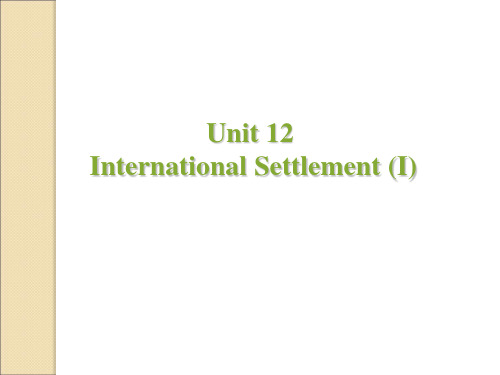
Questions
1. In your opinion, which country receives more remitted education expenses, China or USA? Why?
2. When would the buyer agree to sell on cash in advance? 3. Why would most traders choose letter of credit? 4. Why is open account least risky for the buyer? 5. Will the seller surely receive payment under
educational expenses, inheritance, etc.
International payment methods
Cash in advance Letter of credit Documentary collection Open account
Payment Risks to the Seller (Exporter)
Unit 12 International Settlement (I)
Financial activities that call for international payments
1. Commercial settlements 2. Payments for the services rendered 3. Payments between governments 4. Transfer of funds among countries 5. Others payments, such as overseas remittances,
英语课件Chapter12 Schools of Ls

Phonology (ical) oppositions
• 1. N. Trubetzkoy: Principle of Phonology (1939). • Phonetics & phonology: different for parole & langue. Phoneme: an abstract unit of the sound system. • 2. Contributions: • (1) distinctive functions of speech sounds and an accurate definition for the phoneme • (2) distinctions between phonetics and phonology, the sphere of phonological studies
12.2.1 Malinowski‟s theories
• 1. Language “is to be regarded as a mode of action, rather than as a counterpart of thought”. • 2. The meaning of an utterance comes from its relation to the situational context in which it occurs. • 3. Three types of situational context: • (1) situations in which speech interrelates with bodily activity; (2) narrative situations; • (3) situations in which speech is used to fill a speech vacuum—phatic communion.
新编金融英语教程 Chapter12 Commercial Banks
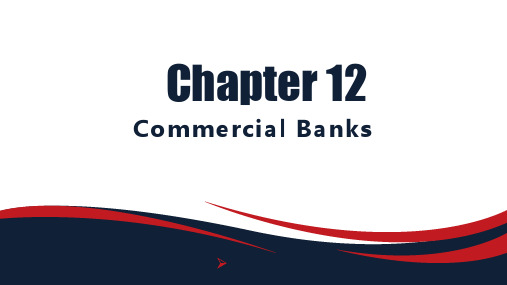
liquidator [ˈlɪkwɪdeɪtə(r)] 清算者
spread [spred] 价差
receiver [rɪˈsi:və(r)] 接收者
redemption [rɪˈdempʃn] 赎回
regulate [ˈregjuleɪt] 监管
12.3 Language Notes
II. Phrases
12.3 Language Notes
II. Phrases
• make loans • middle business • money multiplier effect • mortgage loans • mutual funds • net interest income • non-interest incomes • off-balance-sheet assets • origination fee
introduce the working mechanism in which a commercial bank creates money and makes money. Finally, it will introduce the regulations of commercial banks in the USA.
A. 国家银行 B. 地方银行 C. 州政府监管的 D. 并购申请 E. 商业结构 F. 商业银行 G. 存款利息 H. 贷款利息 I. 国家监管的 J. 投资机构
12.3 Language Notes
III. Sentences
4. The amount of money earned by a commercial bank is determined by the spread between the interest it pays on deposits and the interest it earns on loans, which is known as net interest income.
CHAPTER12 Long-Term Liabilities (《Financial Accounting 2th》PPT课件)
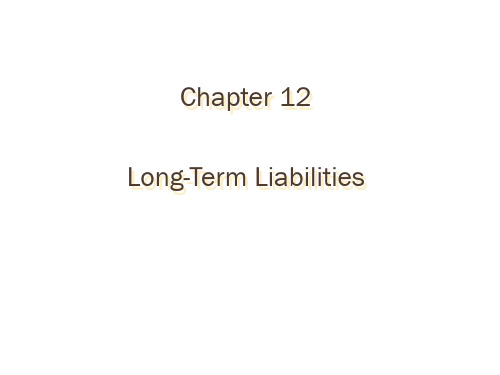
Unsecured notes – Financial instruments that rely on the borrower’s general credit worthiness for their repayment.
RIGHTS OF BORROWER AND LENDER IN DEFAULT
whichever is longer.
VALUING CURRENT LIABILITIES
Valuing current liabilities on the balance sheet: Ignore present value Report at face value Primary concern is to ensure that all existing current liabilities are reported on the balance sheet.
MARKET VALUE OF BONDS
The current market value (present value) of a bond is a function of three factors:
Dollar amounts to be received Length of time until the amounts are received Market interest rate
RIGHTS OF BORROWER AND LENDER IN DEFAULT
In general, lenders get some decisionmaking or control upon default.
Collateral or Security – Assets the lender can seize if the borrower defaults (e.g., home mortgages are secured by the house).
RIGHTS OF BORROWER AND LENDER IN DEFAULT
whichever is longer.
VALUING CURRENT LIABILITIES
Valuing current liabilities on the balance sheet: Ignore present value Report at face value Primary concern is to ensure that all existing current liabilities are reported on the balance sheet.
MARKET VALUE OF BONDS
The current market value (present value) of a bond is a function of three factors:
Dollar amounts to be received Length of time until the amounts are received Market interest rate
RIGHTS OF BORROWER AND LENDER IN DEFAULT
In general, lenders get some decisionmaking or control upon default.
Collateral or Security – Assets the lender can seize if the borrower defaults (e.g., home mortgages are secured by the house).
第二章 国际收支《国际金融实务》PPT课件

四、国际收支不平衡的调节 (一)国际收支的自动调节机制
(二)国际收支的政策调节
1.外汇缓冲政策 2.财政和货币政策 3.汇率政策 4.直接管制。
第四节 我国的国际收支和国际收支平衡表
我国国际收支平衡表的编制原则
1
按IMF《国际收支 手册》第5版规定 的各项原则编制, 采用复式记账法的 原理所有交易均发 生在我国大陆居民 与非我国大陆居民 之间。
二、我国国际收支平衡表的分析
(一)动态分析 (二)静态分析
三、我国的国际投资头寸表
• 2006年5月25日,国家外汇管理局首次 公布我国国际投资头寸表。该报表记录 了2004年、2005年我国(不含港澳台) 对世界其他国家或地区的金融资产和负 债存量情况。目前,我国按季度、年度 公布国际投资头寸表。
差额
贷方(+) 借方(-)
项
目
Ⅱ.资本和金融账户 A.资本账户 a.资本转移 1.各级政府 2.其他部门 b.非生产、非金融资产的收买/放弃 B.金融账户 a.直接投资 1.国外 2.在报告经济体内 b.证券投资 1.资产 2.负债 c.其他投资 1.资产 2.负债 d.储备资产 1.货币性黄金 2.特别提款权 3.在基金组织的储备头寸 4.外汇储备 5.其他债权
Ⅲ.错误和遗漏账户
差额
贷方(+) 借方(-)
经常账户(Current Account,也译为“经常 项目”或“往来账户” )
货物(Goods) 服务(Services) 收益(Income,或译为“收入” ) 经常转移(Current Transfers)
资本和金融账户(Capital and Financial Account) ●资本账户(Capital Account)
国际贸易实务双语教程(第4版)chapter12

The contract is discharged where the breach results in the innocent party treating it as rescinded and where it has the effect of depriving the party who has further undertakings still to perform of substantially the whole benefit which it was the intention of the parties as expressed in the contract as the consideration for performing those undertaking.
2 Stipulate the Force Majeure Clause in a Way to List the Contents
3 Stipulate the Force Majeure Clause in a Way to Colligation
Section Three Arbitration
1) Proofs for claiming 2) Claim amount 3) Claim Period 4) Seller's Responsibility for Settlement
The sellers may settle the claim upon the agreement of the
Examples of arbitration clauses Please read your text book
Clauses in respect of claim in an import and export contract can be fixed as follows:
2 Stipulate the Force Majeure Clause in a Way to List the Contents
3 Stipulate the Force Majeure Clause in a Way to Colligation
Section Three Arbitration
1) Proofs for claiming 2) Claim amount 3) Claim Period 4) Seller's Responsibility for Settlement
The sellers may settle the claim upon the agreement of the
Examples of arbitration clauses Please read your text book
Clauses in respect of claim in an import and export contract can be fixed as follows:
第一章 国际收支 《国际金融实务》PPT课件

备的增减和净误差与遗漏项目得到平衡,使最终的账面差额即总差额(overall balance) 必然为零。
• 因此,这种平衡成为账目上的平衡,而不是真实意义上的平衡。
一、国际收支的平衡与失衡 • 2.国际收支的失衡 • 从另一方面看,国际收支又常常是不平衡的,不平衡的表现也有两个方面:
(1)国际收支平衡表中的各个项目一般是不平衡的,总会出现一 定的差额,这就是所谓的局部差额,这些局部差额很可能会引起
五、国际收支失衡的调节 • 图1-2 浮动汇率下国际收支自动调节机制
(二)国际收支的政策调节 • 1. 外汇缓冲政策 • 2.支出转换政策
(1)财政政 (2)策货。币政 (3)策汇。率政 (4)策直。接管
制政策。
(二)国际收支的政策调节 • 3.国际经济合作政策
(1)协调经济 政策。
(2)加强国家 间(的3)信充用分合发作挥。 IMF等国际金融 机构在平衡一国 国际收支中的作
三、国际收支失衡的原因
1.经济周期
2.国民收入
3. 货币价值
4.经济结构 • 结构性不平衡是指一国产业结构不适应世界市场的变化而出现的国际收支不平衡。
结构性失衡包括两层含义: • (1)因一国的国民经济和产业结构变动的滞后和困难引起的国际收支失衡。 • (2)因一国的产业结构单一、产品价格弹性较大引起的国际收支失衡。
供给的交易,即资产减少、负债增加,都记入贷方。
三、国际收支平衡表的构成
• (一)国际收支平衡表的结构
I.经常账户 A.货物和服务 a.货物 1.一般商品 2.用于加工的货物 3.货物修理 4.各种运输工具在港口购买的货物 5.非货币性黄金 b.服务 1.加工服务 2.维护和维修服务 3.运输 4.旅游 5.建设 6.保险和养老金服务 7.金融服务 8.知识产权使用费 9.电信、计算机和信息服务 10.其他商业服务 11.个人、文化和娱乐服务 12.别处未提及的政府服务
• 因此,这种平衡成为账目上的平衡,而不是真实意义上的平衡。
一、国际收支的平衡与失衡 • 2.国际收支的失衡 • 从另一方面看,国际收支又常常是不平衡的,不平衡的表现也有两个方面:
(1)国际收支平衡表中的各个项目一般是不平衡的,总会出现一 定的差额,这就是所谓的局部差额,这些局部差额很可能会引起
五、国际收支失衡的调节 • 图1-2 浮动汇率下国际收支自动调节机制
(二)国际收支的政策调节 • 1. 外汇缓冲政策 • 2.支出转换政策
(1)财政政 (2)策货。币政 (3)策汇。率政 (4)策直。接管
制政策。
(二)国际收支的政策调节 • 3.国际经济合作政策
(1)协调经济 政策。
(2)加强国家 间(的3)信充用分合发作挥。 IMF等国际金融 机构在平衡一国 国际收支中的作
三、国际收支失衡的原因
1.经济周期
2.国民收入
3. 货币价值
4.经济结构 • 结构性不平衡是指一国产业结构不适应世界市场的变化而出现的国际收支不平衡。
结构性失衡包括两层含义: • (1)因一国的国民经济和产业结构变动的滞后和困难引起的国际收支失衡。 • (2)因一国的产业结构单一、产品价格弹性较大引起的国际收支失衡。
供给的交易,即资产减少、负债增加,都记入贷方。
三、国际收支平衡表的构成
• (一)国际收支平衡表的结构
I.经常账户 A.货物和服务 a.货物 1.一般商品 2.用于加工的货物 3.货物修理 4.各种运输工具在港口购买的货物 5.非货币性黄金 b.服务 1.加工服务 2.维护和维修服务 3.运输 4.旅游 5.建设 6.保险和养老金服务 7.金融服务 8.知识产权使用费 9.电信、计算机和信息服务 10.其他商业服务 11.个人、文化和娱乐服务 12.别处未提及的政府服务
金融英语(4-13)ppt课件(全)

➢ Accommodating investment needs.
Financial institutions serve as intermediaries within the financial markets to channel funds from investors to corporations.
➢ Regulators.
Most countries need regulators who control their financial institutions and regulate dealings in securities markets with the objects of ensuring that the financial institutions are able to honour their commitments, that people have access to relevant information before they enter into contracts, and dealing in securities is fair.
Chapter 4 Financial Markets 4.1 Types of Financial Markets
Direct financial market and indirect financial market
• In direct financial market, borrowers borrow funds directly from lenders without using a third party service.
• International financial markets allow a number of traders who are not only across the country but also around the world to make transactions.
Financial institutions serve as intermediaries within the financial markets to channel funds from investors to corporations.
➢ Regulators.
Most countries need regulators who control their financial institutions and regulate dealings in securities markets with the objects of ensuring that the financial institutions are able to honour their commitments, that people have access to relevant information before they enter into contracts, and dealing in securities is fair.
Chapter 4 Financial Markets 4.1 Types of Financial Markets
Direct financial market and indirect financial market
• In direct financial market, borrowers borrow funds directly from lenders without using a third party service.
• International financial markets allow a number of traders who are not only across the country but also around the world to make transactions.
新编金融英语教程第十二章
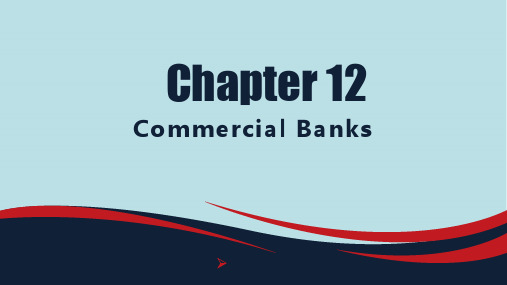
12.2 Key Points
12.2.3 Working Mechanism of Commercial Banks
➢ In a fractional reserve banking system, commercial banks are permitted to create money by allowing multiple claims to assets on deposit. Banks create credit that did not previously exist when they make loans. This is sometimes called the money multiplier effect. There is a limit to the amount of credit lending institutions can create this way. Banks are legally required to keep a certain minimum percentage of all deposit claims as liquid cash. This is called the reserve ratio.
Corporation
Federal Reserve System
Office of the Cቤተ መጻሕፍቲ ባይዱmptroller of the
Currency
State Authorities
12.3 Language Notes
I. Words
charter [ˈtʃɑ:tə(r)] 特许权
retail [ˈri:teɪl] 零售
claim [kleɪm] 请求权
国际金融实务完整版课件
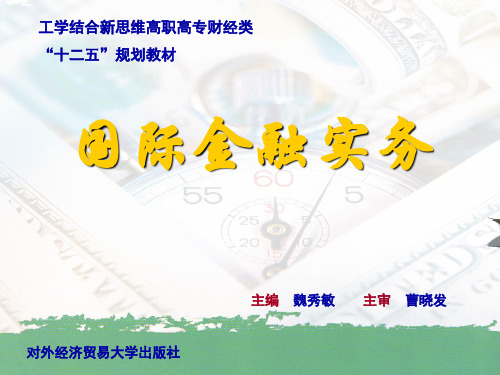
国际储备规模管理是对国际储备规模进 行确定和调整,使国际储备数量保持适度水 平。
32
决定贮备水平的要素
1、经济因素,如对外贸易状况、国际收支 流量、国际融资能力;
2、政治因素,如一国外汇与外贸管制程度、 汇率制度、外汇政策。
这些因素错综复杂,相互影响。一国国际 储备水平应以适合本国经济均衡发展需要为宜, 不存在具体标准,更不存在各国通用模式。
33
贮备水平确定
一国国际储备量应与该国一年贸易进口总 额保持一定比例关系,一般以本国进口总额的 40%作为标准,实施外汇管制国家的储备可稍 低,但不能低于20%;不实施外汇管制国家的 储备应稍高,但不超过50%。
对大多数国家而言,储备进口率保持在3040%最为适度,即一国的储备量应以满足3个月 的净进口额为宜。
22
2008年上半年,我国积极应对国际经济环境不 确定因素带来的挑战,努力克服国内严重自然灾害 造成的困难,国民经济总体保持平稳较快运行态势。
2008年下半年,美国次贷危机引发的国际金融 危机席卷全球,加大了我国国际收支运行的不确定 性。我国政府在继续关注国际收支较大顺差的同时, 密切跟踪形势变化,时刻注意防范各种风险。
34
资料卡
不同国家的国际储备水平
在1991年,全世界的国际储备总额正好能够支 付3个月的进口额。其中,低收入国家为5.1个月, 中等收入国家为3.6个月,高收入国家为2.7个月。 在1994年,中国的国际储备能够支付3.8个月的进 口,印度为3.6个月,除印度和中国之外的低收入 国家为4.2个月,重债国为5.7个月,美国为2.3个月, 日本为2.4个月,德国为2.6个月,法国为2.7个月, 英国为1.4个月。
15
三、国际收支不平衡的影响
32
决定贮备水平的要素
1、经济因素,如对外贸易状况、国际收支 流量、国际融资能力;
2、政治因素,如一国外汇与外贸管制程度、 汇率制度、外汇政策。
这些因素错综复杂,相互影响。一国国际 储备水平应以适合本国经济均衡发展需要为宜, 不存在具体标准,更不存在各国通用模式。
33
贮备水平确定
一国国际储备量应与该国一年贸易进口总 额保持一定比例关系,一般以本国进口总额的 40%作为标准,实施外汇管制国家的储备可稍 低,但不能低于20%;不实施外汇管制国家的 储备应稍高,但不超过50%。
对大多数国家而言,储备进口率保持在3040%最为适度,即一国的储备量应以满足3个月 的净进口额为宜。
22
2008年上半年,我国积极应对国际经济环境不 确定因素带来的挑战,努力克服国内严重自然灾害 造成的困难,国民经济总体保持平稳较快运行态势。
2008年下半年,美国次贷危机引发的国际金融 危机席卷全球,加大了我国国际收支运行的不确定 性。我国政府在继续关注国际收支较大顺差的同时, 密切跟踪形势变化,时刻注意防范各种风险。
34
资料卡
不同国家的国际储备水平
在1991年,全世界的国际储备总额正好能够支 付3个月的进口额。其中,低收入国家为5.1个月, 中等收入国家为3.6个月,高收入国家为2.7个月。 在1994年,中国的国际储备能够支付3.8个月的进 口,印度为3.6个月,除印度和中国之外的低收入 国家为4.2个月,重债国为5.7个月,美国为2.3个月, 日本为2.4个月,德国为2.6个月,法国为2.7个月, 英国为1.4个月。
15
三、国际收支不平衡的影响
国际金融实务课件

监管措施:包括市场准入、交 易限制、信息披露等
风险管理:包括风险识别、风 险评估、风险控制等
Part Five
电汇:通过银行网络进行快 速、安全的资金转移
信用证:由银行担保的支付 方式,确保买卖双方的权益
托收:通过银行收取货款, 适用于小额、频繁的贸易
汇票:由银行签发的支付凭 证,可用于国际贸易和国内 贸易
构成:包括外汇市场、国际债券市场、 国际股票市场等
特点:全球性、流动性、风险性、复杂 性、多样性、开放性
参与者:包括各国政府、中央银行、商 业银行、投资银行、企业、个人等
交易方式:包括现货交易、期货交易、 期权交易、互换交易等
监管机构:包括国际货币基金组织、世 界银行、国际清算银行等
影响因素:包括政治、经济、社会、文 化、技术等
监管机构:各国央 行、国际金融监管 机构等
监管手段:法律、 法规、政策等
国际货币基金组织(IMF):维护全球金 融稳定,促进国际货币合作
国际证监会组织(IOSCO):制定证券 监管标准,促进全球证券市场健康发展
世界银行(WB):提供贷款和技术援 助,支持发展中国家的经济发展
国际保险监督官协会(IAIS):制定保 险监管标准,促进全球保险市场健康发 展
国际租赁融资:通过租赁方式进行 融资,具有资金来源广泛、期限灵 活、风险较低等特点。
直接投资:投资者直接参与企业的经营管理,如设立子公司、合资企业等
间接投资:投资者通过购买股票、债券等方式参与企业经营,如投资股票、债券等
风险类型:政治风险、经济风险、法律风险、市场风险等 风险管理:通过风险评估、风险控制、风险转移等方式进行风险管理
国际清算银行(BIS):促进国际金融合 作,维护全球金融稳定
- 1、下载文档前请自行甄别文档内容的完整性,平台不提供额外的编辑、内容补充、找答案等附加服务。
- 2、"仅部分预览"的文档,不可在线预览部分如存在完整性等问题,可反馈申请退款(可完整预览的文档不适用该条件!)。
- 3、如文档侵犯您的权益,请联系客服反馈,我们会尽快为您处理(人工客服工作时间:9:00-18:30)。
The Eurocurrency Market
• Although many of the most burdensome regulations and costs have been eased or abolished, the Eurocurrency market still exists. It will continue to exist as long as there are profitable opportunities to engage in offshore financial transactions. • Because of the ongoing erosion of domestic regulations, these cost and return differentials are much less significant today than they were in the past. As a consequence, the domestic money market and Eurocurrency market are now tightly integrated for most of the major currencies, effectively creating a single worldwide money market for each participating currency.
countries in which currencies of the other country are denominated in. In the Eurobond market, Eurobonds are issued directly by the final borrowers. —The Eurocurrency market enables investors to hold shortterm claims on commercial banks, which then act as intermediaries to transform these deposits into long-term claims on final borrowers.
It is the market having special rate structure
•
The most important characteristic of the Eurocurrency market is that loans are made on a floating-rate basis. Interest rates on loans to governments and their agencies, corporations, and nonprime banks are set at a fixed margin above LIBOR for the given period and currency chosen. At the end of each period, the interest for the next period is calculated at the same fixed margin over the new LIBOR. • In general, Eurocurrency spreads are narrower than domestic money market spreads .
The Eurocurrency Market
• The Eurobond and Eurocurrency markets are often confused with each other. —In the Eurobond market, Eurobonds are sold outside the
The Eurocurrency Market
• The dominant Eurocurrency remains the U.S. dollar, but the importance of the Eurodollar waxes and wanes with the strength of the U.S. dollar. With dollar weakness in the latter parts of both the 1970s and 1980s, other currencies particularly the Deutsche Mark and the Swiss franc increased in importance. Dollar strength in the 1990s again boosted the relative importance of the Eurodollar. The euro has now become an important currency for denominating Eurocurrency loans and Eurobonds.
The Eurocurrency Market
•
Note that the prefix Euro as used here has nothing to do with the currency known as the euro. • The Eurocurrency is a name given to those currencies outside their origin country. • The Eurocurrency market isn’t confined to the European financial centers. It is the off-shore financial market of all world. • Not only short-term loans but also medium-term or longterm loans are operated in the market.
The Eurocurrency Market
• These costs and restrictions includes:
—Reserve requirements that lower a bank’s earning asset base —Special charges and taxes levied on domestic banking
It has high degree of liberty.
• The maturity of a loan can vary from approximately 3-10 years. Lenders in this market are almost exclusively banks. In any single loan, there normally will be a number of participating banks that form a syndicate. The managers charge the borrower a once-and-for-all syndication fee of 0.25%-2% of the loan value, depending on the size and type of the loan.
It has high degree of liberty
• The Eurocurrency Market operates very freely, investors and raisers can move in or out freely, the margin, or spread between the lending bank’s cost of funds and the interest charged the borrower, varies a good deal among borrowers and is based on the borrower’s perceived riskiness. • The repayment period vary in accordance with the borrower’s n Market
Features of the Eurocurrency Market
—It is the capital market with the nature of super-nation or
without nationality. —It is a wholesale market. —It has high degree of liberty. —It is the market having special rate structure.
transactions —Requirements to lend money to certain borrowers at concessionary rates —Interest rate ceilings on deposits or loans —Rules or regulations that restrict competition among banks
Chap 12
International Financial Markets
International Financial Markets
• International financial markets are the places in which international financial transactions are taken place. These businesses include long-term and shortterm debts, transactions of forex and gold. • A Eurocurrency is a dollar or other freely convertible currency deposited in a bank outside its country of origin. • The Eurocurrency market, which is also called offshore financial market, consists of those banks, that is, Eurobanks that accept deposits and make loans in foreign currencies for the non-residents.
